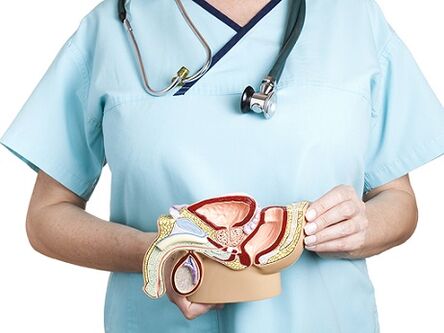Papules are swollen formations that appear on a person's skin and mucous membranes. They are not really a disease, but only serve as an external manifestation of the infection of the body with HPV - the human papillomavirus.
The papillomavirus is present in many different strains, some of which are dangerous because the neoplasms have the property of malignant transformation, ie they can turn into malignant tumors.
The reasons for the appearance of papillae in the penis

Papules are benign formations on the skin or mucous membranes of an ant-like nature.
The human papillomavirus is transmitted in various ways, from a sick to a healthy one. The main method is sexual, with unprotected intercourse. But you can catch the virus at home, in contact with a carrier, if there are defects in the integrity of the body or mucous membranes, through the blood and other fluids that have been infected with the virus.
It is quite difficult to completely "eliminate" a virus that has already entered the body, but in about 90% of cases there is an independent treatment, ie the immune system itself "kills" the virus. However, in some cases, the disease takes on a recurrent nature and can last for many years.
Particularly dangerous are strains with the ability to malignancy, ie the transformation of a tumor into a malignant one.
HPV has a long incubation period, with strong immunity, it can last from a month to a year.
But as soon as the immune system is weakened, it will be immediately felt. Symptoms of its presence are formations in the body and mucous membranes, which may be round, oval or oblong in shape and vary in size, from a few millimeters to a few centimeters.
More than 600 strains of the virus are known in medicine, of which more than 40 are capable of causing cancer of the genitals and anus in men and women. They are the ones that cause papillomas in the penis, which are referred to as genital warts.
Some of the papules are harmless to human health, others are capable of causing an annoying cosmetic defect - warts, and others threaten the body with the most dangerous disease - cancer. There is medical evidence between cervical and breast cancer that develops from infection with certain HPV strains.
If a virus that can cause papillomas in the genitals enters the body, then its main route of entry is considered to be sexual. Intercourse, bisexual and homosexual relationships are especially dangerous. But the virus may well be congenital - the fetus becomes infected when it passes through the birth canal of an infected mother. There is also a risk of infection in skin lesions when you visit the pool, public toilet, bath, sauna, gym, during waxing, shaving.
Signs and symptoms of the disease

Symptoms depend on the location, number and size of the papillae.
Most often, papillae in the penis affect the head of the organ, "settle" along the foreskin, form colonies in the bridle and may even penetrate the urethra.
With a strong proliferation of "cauliflower" papillae during sexual intercourse, urination can be injured, sore, and even bleed.
As it is a viral disease, the period of activation of papillary growth is accompanied by a sharp decrease in immunity. A person feels weak, lethargic, his body temperature may rise, more often it is maintained at hypopyretic levels (37 - 37, 5 ° C). As immunity is reduced, an infected person can easily catch a cold and "pick up" ARVI and ARI.
The proliferation of papillae can lead to suffocation - narrowing of the foreskin.
Due to this condition, a special lubricant accumulates on the head of the penis - sebum. Infection can lead to the development of a dangerous disease, therefore, if even isolated nipples are detected, it is urgent to consult a doctor. Individual tumors can be removed very quickly and almost painlessly, preventing them from growing and a high risk of degeneration into a malignant tumor.
Necessary exams and tests
The presence of papilloma is determined by the doctor visually, but other studies are needed to determine the strain and the degree of risk to the patient. The patient gives blood for standardization using PCR, a Digene screening test, and is tested for the presence of sexually transmitted diseases, since in the vast majority of cases HPV is "bound" to STDs.
If papilloma penetrates the urethra, urethroscopy is performed. The doctor may prescribe a biopsy if the growth is too great or if doctors suspect that the formation has begun to degenerate into a cancerous tumor.
Methods of treatment and removal of papillomas

It is impossible to completely remove the human papillomavirus from the body of the infected person, sometimes it remains in him until the end of the patient's life. Drugs to fight HPV are the use of antiviral drugs and immunomodulators that stimulate the activity of the individual's own immunity.
Basically, the actions of doctors are aimed at eliminating the external signs of the presence of a virus, ie the papillomas themselves, warts and genital warts.
Only in the case of cancerous degeneration is complex treatment applied, which includes surgery and the use of chemotherapy to eliminate the threat of tumor spread.
The following treatment methods are used to remove papillomas in the penis:
- Surgical removal.
- Electrocoagulation.
- Laser formulations (neodymium or carbon dioxide).
- Cold destruction - destruction of a tumor using liquid nitrogen. Cryopreservation can be applied or aerosolized.
- Cauterization with chemicals.
In most cases, the use of these methods is sufficient to remove the papilloma and prevent its recurrence.
The method of treatment is chosen by the doctor depending on the degree of damage, the type of tumor, the state of health of the patient and his age.
There is a specialized vaccine used in women to prevent the most dangerous disease - squamous cell carcinoma, or cervical cancer. It has been shown to be caused by one of the dangerous strains of the human papillomavirus, since in the absence of HPV in the body, this type of cancer does not occur.
Unfortunately, there is currently no vaccine that can prevent infection with other types of human papillomavirus, including those that cause growths in narrow male organs. The only effective way to protect yourself is still to use condoms during sexual intercourse, as well as to maintain personal hygiene, a careful attitude towards possible contamination in public places.
Prognosis and possible complications

Doctors have concluded that in 90% of all cases of HPV infection, if a person has strong immunity, the body can deal with the virus independently within 24 months. But this observation only applies to certain strains of the human papillomavirus, which are not capable of causing cancer.
The most dangerous complication should be considered malignancy, ie the transformation of the papilla into cancer. But only a fraction of HPV strains have such properties. The sad consequences can be prevented with early access to medical help and early diagnosis.
In rare cases, after removal of the papilloma, tumors may form in and around the scar tissue if the virus is actively multiplying in the patient's body due to weakened immunity. In such a situation, repeated removal of the papillae and overall strengthening of the patient's immunity will be required to prevent further development of the formations.
In most cases, the prognosis is positive if the disease is not very advanced. But this rarely happens with genital warts, as their development causes severe discomfort to the man and he quickly turns to doctors.














































































